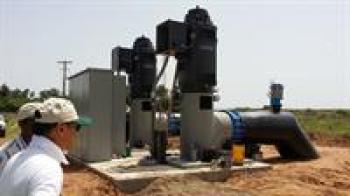Taskforce strives improve ag water management
An LSU AgCenter taskforce is identifying ways to help farmers irrigate more efficiently and improve water quality. The group brings together AgCenter extension agents and researchers who are working to fill data gaps and enhance outreach efforts as Louisiana farmers face increasingly complex decisions about water management.
Greater irrigation efficiency in Louisiana is critical, according to Stacia Davis, irrigation engineer at the AgCenter Red River Research Station in Bossier City. In some parts of the state, groundwater supplies are dwindling and becoming unsuitable for use on crops. Inefficient irrigation costs farmers money and encourages nutrient runoff, which negatively affects nearby waterways.
Davis said members of the taskforce are planning projects to examine the efficiency of various irrigation methods and technologies. For example, Davis is studying the use of soil moisture sensors to aid decisions about irrigation scheduling. Other projects include research on how different irrigation strategies affect crop and soil health.
“This is a diverse group from both research and extension that’s trying to find answers,” said Rogers Leonard, AgCenter program leader for plant and soil sciences. “This group is going to provide educational resources using science-based data. Water is an important issue for Louisiana right now — not only water quantity, but also quality.”
A significant portion of Louisiana agriculture is made up of water-intensive crops such as soybeans, corn and rice. A total of 1.3 million acres of the state’s farmland are irrigated, said AgCenter economist Naveen Adusumilli.
Well-timed and efficiently managed irrigation can lower costs, but many farmers’ options are limited by the type of water and energy they have access to, Adusumilli said.
It is cheaper to pump water using electricity. But if a hook-up cannot be installed, diesel must be used. If surface water is not available, farmers must put down a well to pump groundwater, which is more expensive.
Many farmers in northwestern Louisiana face the dilemma of not having surface water, which forces them to irrigate with water from a declining aquifer. However, the Natural Resources Conservation Service’s recently-completed Red Bayou Watershed Project is helping change that.
Two intake pumps in the Red River send water to Red Bayou, which forms three pools in Caddo Parish. Farmers in the area can now pump water from those pools, which will help reduce aquifer overdraft and soil erosion, NRCS district conservationist Brian Baiamonte told the AgCenter taskforce at its Feb. 18 meeting.
“There had been a perception that the river wasn’t suitable for irrigation, but we did tests and it is,” Baiamonte said. “This project can provide irrigation to up to 12,000 acres.”
Changyoon Jeong, AgCenter water quality expert, has been collecting samples from four sites along Red Bayou and one site at the Red River Research Station. He’s found that salt in Red Bayou’s water decreases by 48 percent as it flows downstream. However, phosphorus and nitrogen increase going downstream.
“There is lots of nutrient runoff in this area,” Jeong said. “Phosphorus is 76 percent increased by site No. 5. We can identify hotspots and offer best management practices to those growers.”
Many farmers around Louisiana are becoming interested in tailwater recovery, which is a practice whereby water that runs to the ends of rows is collected and reused, Jeong said. He is studying ways to remove nutrient particles from tailwater before reusing it.
While it is a good option in some cases, tailwater recovery relies on having excess water in the field. The ultimate goal of the taskforce is to work with farmers to develop irrigation strategies that use less water but make the best use of it, Davis said, which has both economic and environmental benefits.
- Log in to post comments

